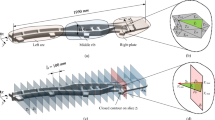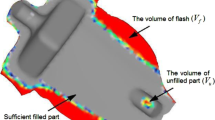Abstract
Preform design is one of the most important aspects in forging process design. An automatic method of preform optimal design based on the bi-directional evolutionary structural optimization is presented in this paper. The complete filling of die cavity with less flash and uniform deformation of material are the goals of the preform optimal design. A new criterion of element addition/deletion is proposed. The new criterion is associated with objective functions. The technique of element information tracking and transferring is introduced and the variables can be transmitted from the final mesh of the forging to the background grid that represents the preform. The method of boundary smooth fitting of the preform using the B-Spline curve is given. The preform optimal design for an H-shaped forging is carried out to demonstrate the effectiveness of the proposed method. A near net-shape forming is achieved meanwhile the uniform deformation is obtained.
Similar content being viewed by others
References
Jan L, Malte S, Bernd-Arno B (2016) Investigation of a moveable flash gap in hot forging. J Mater Process Technol 231:199–208
Chen G, Zhang S, Zhang H, Han F, Wang G, Chen Q (2018) Controlling liquid segregation of semi-solid az80 magnesium alloy by back pressure thixoextruding. J Mater Process Technol 259:88–95
Sheu JJ, Yu CH (2009) Preform and forging process designs based on geometrical features using 2D and 3D FEM simulations. Int J Adv Manuf Technol 44:244–254
Badrinarayanan S, Zabaras N (1996) A sensitivity analysis for the optimal design of metal-forming processes. Comput Methods Appl Mech Eng 129:319–348
An H, Green DE, Johrendt J (2010) Multi-objective optimization and sensitivity analysis of tube hydroforming. Int J Adv Manuf Technol 50(1–4):67–84
Chung SH, Fourment L, Chenot JL, Hwang SM (2003) Adjoint state method for shape sensitivity analysis in non-steady forming applications. Int J Numer Methods Eng 57:1431–1444
Roy S, Ghosh S, Shivpuri R (1997) A new approach to optimal design of multi-stage metal forming processes with micro genetic algorithms. Int J Mach Tool Manu 37:29–44
Knust J, Podszus F, Stonis M, Behrens BA, Overmeyer L, Ullmann G (2016) Preform optimization for hot forging processes using genetic algorithms. Int J Adv Manuf Technol 89(5–8):1623–1634
Guan J, Wang GC, Guo T, Song LB, Zhao GQ (2009) The microstructure optimization of h-shape forgings based on preforming die design. Mater Sci Eng A 499:304–308
Ozcelik B, Erzurumlu T (2005) Determination of effecting dimensional parameters on warpage of thin shell plastic parts using integrated response surface method and genetic algorithm. Int Commun Heat Mass 32:1085–1094
Lu WK, Hung SH, Chang YN (2004) Use of response surface methodology to optimize culture medium for production of poly-γ-glutamic acid by Bacillus licheniformis. Int J Appl Sci Eng 2:49–58
Guan Y, Bai X, Liu M, Song L, Zhao G (2015) Preform design in forging process of complex parts by using quasi-equipotential field and response surface methods. Int J Adv Manuf Technol 79(1–4):21–29
Naceur H, Guo YQ, Batoz JL (2004) Blank optimization in sheet metal forming using an evolutionary algorithm. J Mater Process Technol 151:183–191
Shao Y, Lu B, Xu DK, Chen J, Ou H, Long H, Guo PY (2016) Topology-based preform design optimization for blade forging. Int J Adv Manuf Technol 86:1–13
Shao Y, Lu B, Ou H, Cui Z (2013) Preform design optimization for forging process based on the topological approach. AIP Conf Proc 1532:484–490
Shao Y, Lu B, Ou H, Ren F, Chen J (2014) Evolutionary forging preform design optimization using strain-based criterion. Int J Adv Manuf Technol 71:69–80
Shao Y, Guo PY, Liu ZA, Zhou ZY, Cai W (2011) Influence of cross section shapes of preformed blade body for final forging formability based on numerical simulation. Adv Mater Res 189-193:2558–2561
Xie YM, Steven GP (1993) A simple evolutionary procedure for structural optimization. Comput Struct 49:885–896
Querin OM, Steven GP, Xie YM (1998) Evolutionary structural optimization (ESO) using a bidirectional algorithm. Eng Comput 15:1031–1048
Yang XY, Xei YM, Steven GP, Querin OM (2012) Bidirectional evolutionary method for stiffness optimization. AIAA J 37:1483–1488
Zuo ZH, Xie YM, Zhao B (2011) An innovative design based on CAD environment. Adv Mater Res 308-310:1166–1169
Ohmori H, Futai H, Iijima T, Muto A, Hasegawa Y (2004) Structural design of office building by computational morphogenesis(structures). J Arch Build Sci 10(20):77–82
Cui C, Ohmori H, Sasaki M (2003) Computational morphogenesis of 3D structures by extended ESO method. J IASS 44:51–61
Acknowledgments
This research is supported by the Key Program of the National Natural Science Foundation of China (51735008).
Author information
Authors and Affiliations
Corresponding author
Rights and permissions
About this article
Cite this article
Yang, H., Ma, X., Jiao, F. et al. Preform optimal design of H-shaped forging based on bi-directional evolutionary structural optimization. Int J Adv Manuf Technol 101, 1–8 (2019). https://doi.org/10.1007/s00170-018-2906-9
Received:
Accepted:
Published:
Issue Date:
DOI: https://doi.org/10.1007/s00170-018-2906-9




